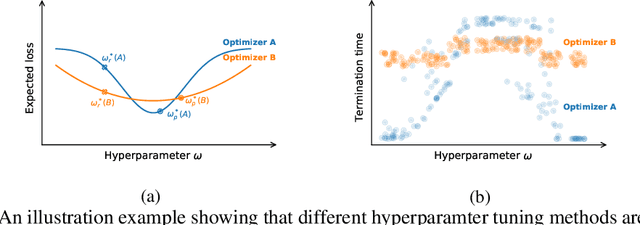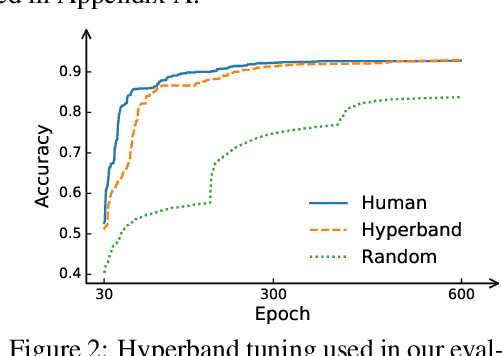Si Si
LoRA Done RITE: Robust Invariant Transformation Equilibration for LoRA Optimization
Oct 27, 2024Abstract:Low-rank adaption (LoRA) is a widely used parameter-efficient finetuning method for LLM that reduces memory requirements. However, current LoRA optimizers lack transformation invariance, meaning the actual updates to the weights depends on how the two LoRA factors are scaled or rotated. This deficiency leads to inefficient learning and sub-optimal solutions in practice. This paper introduces LoRA-RITE, a novel adaptive matrix preconditioning method for LoRA optimization, which can achieve transformation invariance and remain computationally efficient. We provide theoretical analysis to demonstrate the benefit of our method and conduct experiments on various LLM tasks with different models including Gemma 2B, 7B, and mT5-XXL. The results demonstrate consistent improvements against existing optimizers. For example, replacing Adam with LoRA-RITE during LoRA fine-tuning of Gemma-2B yielded 4.6\% accuracy gain on Super-Natural Instructions and 3.5\% accuracy gain across other four LLM benchmarks (HellaSwag, ArcChallenge, GSM8K, OpenBookQA).
Large Language Models are Interpretable Learners
Jun 25, 2024Abstract:The trade-off between expressiveness and interpretability remains a core challenge when building human-centric predictive models for classification and decision-making. While symbolic rules offer interpretability, they often lack expressiveness, whereas neural networks excel in performance but are known for being black boxes. In this paper, we show a combination of Large Language Models (LLMs) and symbolic programs can bridge this gap. In the proposed LLM-based Symbolic Programs (LSPs), the pretrained LLM with natural language prompts provides a massive set of interpretable modules that can transform raw input into natural language concepts. Symbolic programs then integrate these modules into an interpretable decision rule. To train LSPs, we develop a divide-and-conquer approach to incrementally build the program from scratch, where the learning process of each step is guided by LLMs. To evaluate the effectiveness of LSPs in extracting interpretable and accurate knowledge from data, we introduce IL-Bench, a collection of diverse tasks, including both synthetic and real-world scenarios across different modalities. Empirical results demonstrate LSP's superior performance compared to traditional neurosymbolic programs and vanilla automatic prompt tuning methods. Moreover, as the knowledge learned by LSP is a combination of natural language descriptions and symbolic rules, it is easily transferable to humans (interpretable), and other LLMs, and generalizes well to out-of-distribution samples.
Automatic Engineering of Long Prompts
Nov 16, 2023Abstract:Large language models (LLMs) have demonstrated remarkable capabilities in solving complex open-domain tasks, guided by comprehensive instructions and demonstrations provided in the form of prompts. However, these prompts can be lengthy, often comprising hundreds of lines and thousands of tokens, and their design often requires considerable human effort. Recent research has explored automatic prompt engineering for short prompts, typically consisting of one or a few sentences. However, the automatic design of long prompts remains a challenging problem due to its immense search space. In this paper, we investigate the performance of greedy algorithms and genetic algorithms for automatic long prompt engineering. We demonstrate that a simple greedy approach with beam search outperforms other methods in terms of search efficiency. Moreover, we introduce two novel techniques that utilize search history to enhance the effectiveness of LLM-based mutation in our search algorithm. Our results show that the proposed automatic long prompt engineering algorithm achieves an average of 9.2% accuracy gain on eight tasks in Big Bench Hard, highlighting the significance of automating prompt designs to fully harness the capabilities of LLMs.
Scaling Up Dataset Distillation to ImageNet-1K with Constant Memory
Nov 19, 2022Abstract:Dataset distillation methods aim to compress a large dataset into a small set of synthetic samples, such that when being trained on, competitive performances can be achieved compared to regular training on the entire dataset. Among recently proposed methods, Matching Training Trajectories (MTT) achieves state-of-the-art performance on CIFAR-10/100, while having difficulty scaling to ImageNet-1k dataset due to the large memory requirement when performing unrolled gradient computation through back-propagation. Surprisingly, we show that there exists a procedure to exactly calculate the gradient of the trajectory matching loss with constant GPU memory requirement (irrelevant to the number of unrolled steps). With this finding, the proposed memory-efficient trajectory matching method can easily scale to ImageNet-1K with 6x memory reduction while introducing only around 2% runtime overhead than original MTT. Further, we find that assigning soft labels for synthetic images is crucial for the performance when scaling to larger number of categories (e.g., 1,000) and propose a novel soft label version of trajectory matching that facilities better aligning of model training trajectories on large datasets. The proposed algorithm not only surpasses previous SOTA on ImageNet-1K under extremely low IPCs (Images Per Class), but also for the first time enables us to scale up to 50 IPCs on ImageNet-1K. Our method (TESLA) achieves 27.9% testing accuracy, a remarkable +18.2% margin over prior arts.
Preserving In-Context Learning ability in Large Language Model Fine-tuning
Nov 01, 2022Abstract:Pretrained large language models (LLMs) are strong in-context learners that are able to perform few-shot learning without changing model parameters. However, as we show, fine-tuning an LLM on any specific task generally destroys its in-context ability. We discover an important cause of this loss, format specialization, where the model overfits to the format of the fine-tuned task and is unable to output anything beyond this format. We further show that format specialization happens at the beginning of fine-tuning. To solve this problem, we propose Prompt Tuning with MOdel Tuning (ProMoT), a simple yet effective two-stage fine-tuning framework that preserves in-context abilities of the pretrained model. ProMoT first trains a soft prompt for the fine-tuning target task, and then fine-tunes the model itself with this soft prompt attached. ProMoT offloads task-specific formats into the soft prompt that can be removed when doing other in-context tasks. We fine-tune mT5 XXL with ProMoT on natural language inference (NLI) and English-French translation and evaluate the in-context abilities of the resulting models on 8 different NLP tasks. ProMoT achieves similar performance on the fine-tuned tasks compared with vanilla fine-tuning, but with much less reduction of in-context learning performances across the board. More importantly, ProMoT shows remarkable generalization ability on tasks that have different formats, e.g. fine-tuning on a NLI binary classification task improves the model's in-context ability to do summarization (+0.53 Rouge-2 score compared to the pretrained model), making ProMoT a promising method to build general purpose capabilities such as grounding and reasoning into LLMs with small but high quality datasets. When extended to sequential or multi-task training, ProMoT can achieve even better out-of-domain generalization performance.
DC-BENCH: Dataset Condensation Benchmark
Jul 20, 2022



Abstract:Dataset Condensation is a newly emerging technique aiming at learning a tiny dataset that captures the rich information encoded in the original dataset. As the size of datasets contemporary machine learning models rely on becomes increasingly large, condensation methods become a prominent direction for accelerating network training and reducing data storage. Despite numerous methods have been proposed in this rapidly growing field, evaluating and comparing different condensation methods is non-trivial and still remains an open issue. The quality of condensed dataset are often shadowed by many critical contributing factors to the end performance, such as data augmentation and model architectures. The lack of a systematic way to evaluate and compare condensation methods not only hinders our understanding of existing techniques, but also discourages practical usage of the synthesized datasets. This work provides the first large-scale standardized benchmark on Dataset Condensation. It consists of a suite of evaluations to comprehensively reflect the generability and effectiveness of condensation methods through the lens of their generated dataset. Leveraging this benchmark, we conduct a large-scale study of current condensation methods, and report many insightful findings that open up new possibilities for future development. The benchmark library, including evaluators, baseline methods, and generated datasets, is open-sourced to facilitate future research and application.
Learnable Fourier Features for Multi-Dimensional Spatial Positional Encoding
Jun 23, 2021



Abstract:Attentional mechanisms are order-invariant. Positional encoding is a crucial component to allow attention-based deep model architectures such as Transformer to address sequences or images where the position of information matters. In this paper, we propose a novel positional encoding method based on learnable Fourier features. Instead of hard-coding each position as a token or a vector, we represent each position, which can be multi-dimensional, as a trainable encoding based on learnable Fourier feature mapping, modulated with a multi-layer perceptron. The representation is particularly advantageous for a spatial multi-dimensional position, e.g., pixel positions on an image, where $L_2$ distances or more complex positional relationships need to be captured. Our experiments based on several public benchmark tasks show that our learnable Fourier feature representation for multi-dimensional positional encoding outperforms existing methods by both improving the accuracy and allowing faster convergence.
How much progress have we made in neural network training? A New Evaluation Protocol for Benchmarking Optimizers
Oct 19, 2020



Abstract:Many optimizers have been proposed for training deep neural networks, and they often have multiple hyperparameters, which make it tricky to benchmark their performance. In this work, we propose a new benchmarking protocol to evaluate both end-to-end efficiency (training a model from scratch without knowing the best hyperparameter) and data-addition training efficiency (the previously selected hyperparameters are used for periodically re-training the model with newly collected data). For end-to-end efficiency, unlike previous work that assumes random hyperparameter tuning, which over-emphasizes the tuning time, we propose to evaluate with a bandit hyperparameter tuning strategy. A human study is conducted to show that our evaluation protocol matches human tuning behavior better than the random search. For data-addition training, we propose a new protocol for assessing the hyperparameter sensitivity to data shift. We then apply the proposed benchmarking framework to 7 optimizers and various tasks, including computer vision, natural language processing, reinforcement learning, and graph mining. Our results show that there is no clear winner across all the tasks.
Multi-Stage Influence Function
Jul 17, 2020



Abstract:Multi-stage training and knowledge transfer, from a large-scale pretraining task to various finetuning tasks, have revolutionized natural language processing and computer vision resulting in state-of-the-art performance improvements. In this paper, we develop a multi-stage influence function score to track predictions from a finetuned model all the way back to the pretraining data. With this score, we can identify the pretraining examples in the pretraining task that contribute most to a prediction in the finetuning task. The proposed multi-stage influence function generalizes the original influence function for a single model in (Koh & Liang, 2017), thereby enabling influence computation through both pretrained and finetuned models. We study two different scenarios with the pretrained embeddings fixed or updated in the finetuning tasks. We test our proposed method in various experiments to show its effectiveness and potential applications.
Auto Completion of User Interface Layout Design Using Transformer-Based Tree Decoders
Jan 14, 2020



Abstract:It has been of increasing interest in the field to develop automatic machineries to facilitate the design process. In this paper, we focus on assisting graphical user interface (UI) layout design, a crucial task in app development. Given a partial layout, which a designer has entered, our model learns to complete the layout by predicting the remaining UI elements with a correct position and dimension as well as the hierarchical structures. Such automation will significantly ease the effort of UI designers and developers. While we focus on interface layout prediction, our model can be generally applicable for other layout prediction problems that involve tree structures and 2-dimensional placements. Particularly, we design two versions of Transformer-based tree decoders: Pointer and Recursive Transformer, and experiment with these models on a public dataset. We also propose several metrics for measuring the accuracy of tree prediction and ground these metrics in the domain of user experience. These contribute a new task and methods to deep learning research.
 Add to Chrome
Add to Chrome Add to Firefox
Add to Firefox Add to Edge
Add to Edge